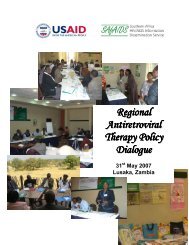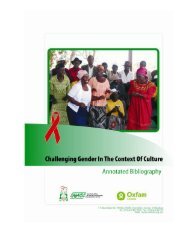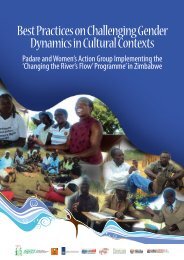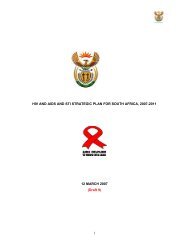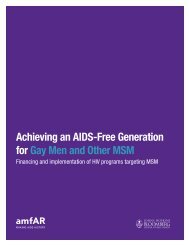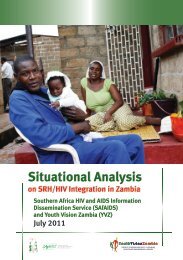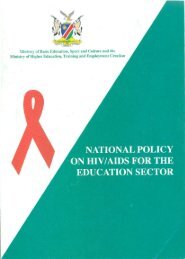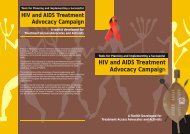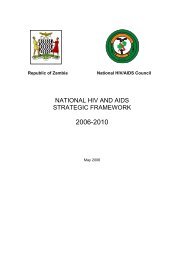Implementation of regional and international HIV prevention - SAfAIDS
Implementation of regional and international HIV prevention - SAfAIDS
Implementation of regional and international HIV prevention - SAfAIDS
- No tags were found...
Create successful ePaper yourself
Turn your PDF publications into a flip-book with our unique Google optimized e-Paper software.
5.0 <strong>HIV</strong>/AIDS INFORMATION COLLECTION,PUBLICATION AND MANAGEMENTIn order to achieve effective <strong>prevention</strong> <strong>of</strong> <strong>HIV</strong> <strong>and</strong> AIDS, it is essential that governmentshave accurate <strong>and</strong> up-to-date information about the populations that will need to accessthe different services. Collection <strong>and</strong> publication <strong>of</strong> this data is thus an important issue. Thissection examines:1. The extent to which good quality national statistics are available <strong>and</strong> relevant for theplanning <strong>and</strong> monitoring <strong>of</strong> <strong>HIV</strong> <strong>and</strong> AIDS <strong>prevention</strong> programmes;2. Whether statistics are disaggregated into useful socio-economic <strong>and</strong> <strong>regional</strong> categoriesin order to enable monitoring <strong>of</strong> the effect <strong>of</strong> policies on different groups, especially themost vulnerable; <strong>and</strong>3. The extent to which NACs have functional records management systems on the national<strong>HIV</strong> <strong>and</strong> AIDS response <strong>and</strong> how these records are analysed <strong>and</strong> reports made available<strong>and</strong> kept.5.1 Availability <strong>of</strong> good quality national statistics for planning <strong>and</strong>monitoring <strong>of</strong> <strong>HIV</strong> <strong>and</strong> <strong>prevention</strong> programmesAvailability <strong>of</strong> credible data <strong>and</strong> statistics has improved dramatically within the last five years.Recent data collection <strong>and</strong> dissemination exercises within the countries include the UNGASSreporting (2008) <strong>and</strong> the Demographic <strong>and</strong> Health Surveys (conducted 2006-2007) which,for Swazil<strong>and</strong>, used population-based testing 4 to determine <strong>HIV</strong> prevalence (Demographic<strong>and</strong> Health Survey, 2007). The DHS included samples <strong>of</strong> blood collected from a nationallyrepresentative sample <strong>of</strong> the population in their homes. This method provided directinformation on <strong>HIV</strong> infection among men, women <strong>and</strong> children. Previously, <strong>HIV</strong> prevalenceestimates were based on sentinel surveillance.32In Zambia there exist other media for ensuring availability <strong>of</strong> reliable quality statistics or dataessential for planning. The Central Statistical Office, MoH <strong>and</strong> NAC are authentic sources <strong>of</strong>national statistics. The country has an efficient system <strong>of</strong> collecting <strong>HIV</strong> <strong>and</strong> AIDS information.Data collected is made public through targeted publications by the Central Statistical Officevia census <strong>of</strong> population <strong>and</strong> households, the Zambia Demographic Health Survey (ZDHS),Zambia Sexual Behavioural Survey (ZSBS) among others. The MOH makes its data publicthrough the Health Management Information System (HMIS). At NAC, the National AIDSCouncil Management Information System (NACMIS) is fast becoming a source <strong>of</strong> valuableconsolidated data.Other co-ordinated publications common to both Swazil<strong>and</strong> <strong>and</strong> Zambia include the JointProgramme Reviews, Annual M&E Reports, the UNGASS report <strong>and</strong> the mid-term reviews forthe national strategies.4 Chin, who heads the WHO Statistics Office in Geneva said statistics on Africa were overblown in theirestimations but the population surveys were reliable. For example, Ethiopia was recently estimated at 5-6%prevalence rate but was later found to be only rated at 1.5%. (MmegiOnline, Vol. 24 No. 162, page 12007)



